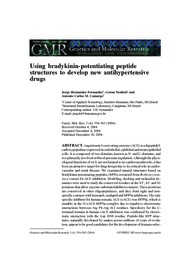Using bradykinin-potentiating peptide structures to develop new antihypertensive drugs.
Using bradykinin-potentiating peptide structures to develop new antihypertensive drugs.
Autoria: HERNANDEZ FERNANDEZ, J.; NESHICH, G.; CAMARGO, A. C. M.
Resumo: Angiotensin I-converting enzyme (ACE) is a dipeptidyl-carboxypeptidase expressed in endothelial, epithelial and neuroepithelial cells. It is composed of two domains, known as N- and C-domains, and it is primarily involved in blood pressure regulation. Although the physiological functions of ACE are not limited to its cardiovascular role, it has been an attractive target for drug design due to its critical role in cardiovascular and renal disease. We examined natural structures based on bradykinin-potentiating peptides (BPPs) extracted from Bothrops jararaca venom for ACE inhibition. Modeling, docking and molecular dynamics were used to study the conserved residues in the S2´, S1´ and S1 positions that allow enzyme-substrate/inhibitor contacts. These positions are conserved in other oligopeptidases, and they form tight and non-specific contacts with lisinopril, enalapril and BPP9a inhibitors. The only specific inhibitor for human somatic ACE (sACE) was BPP9a, which is instable in the N-sACE-BPP9a complex due to repulsive electrostatic interactions between Arg P4-Arg 412 residues. Specificity for the C-terminal domain in human sACE inhibition was confirmed by electrostatic interaction with the Asp 1008 residue. Peptide-like BPP structures, naturally developed by snakes across millions of years of evolution, appear to be good candidates for the development of domain-selective ACE inhibitors with high stability and improved pharmacological profiles.
Ano de publicação: 2004
Tipo de publicação: Artigo de periódico
Unidade: Embrapa Agricultura Digital
Palavras-chave: Dinâmica molecular, Hipertensão, Modelagem, Modeling
Observações
1 - Por padrão são exibidas publicações dos últimos 20 anos. Para encontrar publicações mais antigas, configure o filtro ano de publicação, colocando o ano a partir do qual você deseja encontrar publicações. O filtro está na coluna da esquerda na busca acima.
2 - Para ler algumas publicações da Embrapa (apenas as que estão em formato ePub), é necessário ter, no celular ou computador, um desses softwares gratuitos. Sistemas Android: Google Play Livros; IOS: iBooks; Windows e Linux: software Calibre.
Acesse outras publicações
Acesse a Base de Dados da Pesquisa Agropecuária (BDPA) para consultar o acervo completo das bibliotecas da Embrapa.

